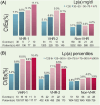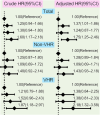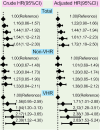Prognostic role of lipoprotein(a) in atherosclerotic cardiovascular disease risk from a perspective on current risk stratification
- PMID: 39492837
- PMCID: PMC11527816
- DOI: 10.1002/mco2.773
Prognostic role of lipoprotein(a) in atherosclerotic cardiovascular disease risk from a perspective on current risk stratification
Abstract
Lipoprotein(a) [Lp(a)] is an emerging predictor for atherosclerotic cardiovascular disease (ASCVD) but the association from a perspective on current risk stratification was unknown. A cohort of 9944 Chinese patients with ASCVD was recruited and refined into very-high-risk (VHR) and non-VHR subgroups according to current guideline. Lp(a) plasma levels were divided by its concentration (<30, 30-50, 50-75, and ≥75 mg/dL) and percentile zones (<25th, 25-50th, 50-75th, 75-90th, ≥90th). Cardiovascular events (CVEs) occurred during an average of 38.5 months' follow-up were recorded. We found that Lp(a) was increased with risk stratification of ASCVD increasing. Prevalence of CVEs had a significantly increasing trend with gradients of Lp(a) elevation in VHR but not in non-VHR subgroup. The adjusted HRs (95%CIs) for CVEs were 1.75(1.25-2.46) in the highest group of Lp(a) ≥75 mg/dL compared with the group of Lp(a) <30 mg/dL as the reference in overall patients, 2.18(1.32-3.58) in VHR subgroup and 1.43(0.93-2.18) in non-VHR subgroup, respectively. The adjusted HRs (95%CIs) at the highest grade of Lp(a) levels (≥90th) were 1.72(1.19-2.50) in overall population, 2.83(1.53-5.24) in VHR subgroup and 1.38(0.86-2.12) in non-VHR subgroup, respectively. These findings suggested that Lp(a) might contribute more to CVEs risk in VHR subgroup of ASCVD.
Keywords: Chinese; atherosclerotic cardiovascular disease; lipoprotein(a); risk stratification.
© 2024 The Author(s). MedComm published by Sichuan International Medical Exchange & Promotion Association (SCIMEA) and John Wiley & Sons Australia, Ltd.
Conflict of interest statement
The authors declare that there is no conflict of interest.
Figures





Similar articles
-
Improvement of evaluation in Chinese patients with atherosclerotic cardiovascular disease using the very-high-risk refinement: a population-based study.Lancet Reg Health West Pac. 2021 Oct 21;17:100286. doi: 10.1016/j.lanwpc.2021.100286. eCollection 2021 Dec. Lancet Reg Health West Pac. 2021. PMID: 34734202 Free PMC article.
-
Optimizing Long-term Cardiovascular Risk Stratification: Integrating Biomarkers into the Very High-Risk ASCVD Definition in Asian Patients.Am J Prev Cardiol. 2025 Mar 16;22:100965. doi: 10.1016/j.ajpc.2025.100965. eCollection 2025 Jun. Am J Prev Cardiol. 2025. PMID: 40213037 Free PMC article.
-
Lipoprotein(a) and Long-Term Cardiovascular Risk in a Multi-Ethnic Pooled Prospective Cohort.J Am Coll Cardiol. 2024 Apr 23;83(16):1511-1525. doi: 10.1016/j.jacc.2024.02.031. J Am Coll Cardiol. 2024. PMID: 38631771
-
Lipoprotein(a) and Atherosclerotic Cardiovascular Disease: Current Understanding and Future Perspectives.Cardiovasc Drugs Ther. 2019 Dec;33(6):739-748. doi: 10.1007/s10557-019-06906-9. Cardiovasc Drugs Ther. 2019. PMID: 31655942 Review.
-
Lipoprotein(a) and Cardiovascular Disease in Chinese Population: A Beijing Heart Society Expert Scientific Statement.JACC Asia. 2022 Nov 15;2(6):653-665. doi: 10.1016/j.jacasi.2022.08.015. eCollection 2022 Nov. JACC Asia. 2022. PMID: 36444328 Free PMC article. Review.
Cited by
-
Lipoprotein(a) as a Risk Factor for Recurrent Ischemic Stroke in Type 2 Diabetes.Diabetes Metab Syndr Obes. 2025 May 17;18:1631-1641. doi: 10.2147/DMSO.S502459. eCollection 2025. Diabetes Metab Syndr Obes. 2025. PMID: 40400768 Free PMC article.
References
-
- Gencer B, Kronenberg F, Stroes ES, Mach F. Lipoprotein(a): the revenant. Eur Heart J. 2017;38(20):1553‐1560. - PubMed
-
- Sandholzer C, Saha N, Kark JD, et al. Apo(a) isoforms predict risk for coronary heart disease. A study in six populations. Arterioscler Thromb. 1992;12(10):1214‐1226. - PubMed
-
- Kamstrup PR, Tybjaerg‐Hansen A, Steffensen R, Nordestgaard BG. Genetically elevated lipoprotein(a) and increased risk of myocardial infarction. JAMA. 2009;301(22):2331‐2339. - PubMed
-
- Tsimikas S. A Test in Context: lipoprotein(a): diagnosis, prognosis, controversies, and emerging therapies. J Am Coll Cardiol. 2017;69(6):692‐711. - PubMed
-
- Ruscica M, Sirtori CR, Corsini A, et al. Lipoprotein(a): knowns, unknowns and uncertainties. Pharmacol Res. 2021;173:105812. - PubMed
LinkOut - more resources
Full Text Sources
Miscellaneous
